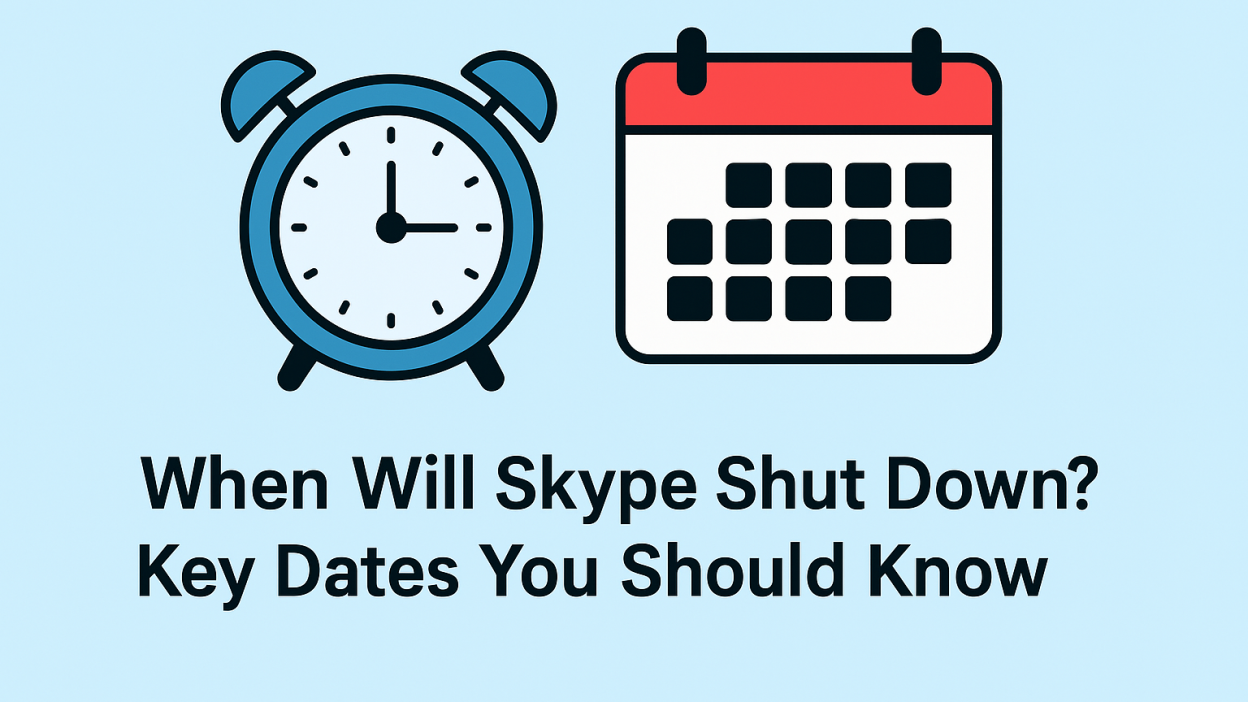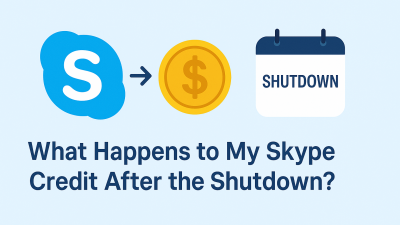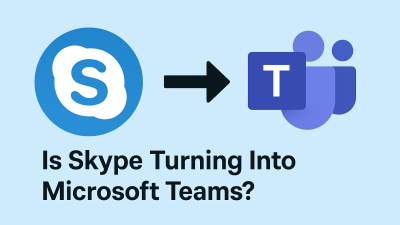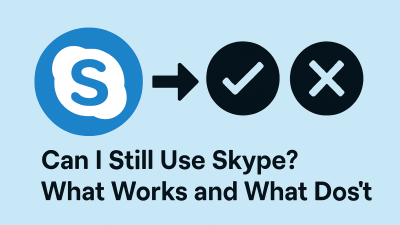May 5, 2025.
That’s the day Skype, the voice and video app that once redefined global communication, will officially shut down. For many users, this might feel like just another tech company shifting focus. But if you’ve relied on Skype for calls across borders, long-distance family chats, team check-ins, or client meetings, this isn’t just a technical update. It’s the disappearance of a platform that’s been a digital constant for years.
Skype isn’t fading quietly. Microsoft has confirmed that its retirement is permanent, affecting both free and paid users worldwide. That means no more logins, no access to your chats or call history, and no way to initiate or receive calls using Skype apps after the deadline.
But what matters most isn’t just the shutdown date itself. It’s the build-up to it, the slow, structured withdrawal that’s already happening around you. It’s the signs that many users are noticing without realizing what they mean.
If you’ve received a prompt to try Teams recently, or noticed that some Skype features aren’t working the way they used to, you’re not imagining it. You’re experiencing the wind-down.
Before the Shutdown: A Timeline Already in Progress
The road to retirement isn’t just a technical choice. It’s a phased-off process, something Microsoft is doing strategically, not abruptly.
You’ve probably already seen the signs, whether you recognized them or not:
-
Visual banners inside Skype encourage you to “Try Teams Free” or “Continue in Microsoft Teams.”
-
Updates to the app that feel less like upgrades and more like quiet nudges away from the platform.
-
New subscriptions, Skype numbers, and paid services are becoming harder to access or modify.
-
Official Microsoft documentation is quietly shifting its support pages toward Teams.
-
Customer support is no longer prioritizing Skype queries the way it used to.
These changes began rolling out in February and March 2025, and they’re part of a coordinated sunset. Microsoft has used similar strategies before, gradually removing features, freezing updates, and redirecting traffic as a way to signal that a product’s life is winding down.
By April, Skype’s backend will likely begin restricting certain user actions: contact syncing, new account creation, or setting up group calls may start to behave differently or generate error messages. This isn’t a bug. It’s part of the structure Microsoft uses to clear the way for something new.
So while May 5 is the date everyone will remember, the phase-out is already well underway. Waiting until the final week could mean missing your chance to export data, notify contacts, or prepare for the shift.
What Happens on May 5, 2025 — and What Doesn’t
On that Monday morning in May, Skype’s infrastructure will be taken offline. That includes:
-
The ability to log in to the Skype desktop, web, or mobile apps.
-
Access to messages, call logs, or synced contacts.
-
All functionality tied to Skype Numbers, voicemail, and subscriptions.
There will be no access, no fallback screen, and no emergency download to retrieve what’s left.
Skype as a service will simply cease to exist.
What won’t happen, and this is important, is that your Microsoft account will not be deleted. If you use that account for Outlook, OneDrive, Xbox, or Teams, those services will remain intact. The retirement is specific to the Skype product, not your Microsoft identity as a whole.
But anything tied to Skype’s own database, your message history, media files, call logs, and voicemail recordings, won’t be accessible through Microsoft Teams unless you’ve already taken steps to migrate or export it.
This is a hard stop. Not a slow fade.
Why This Shutdown Hits Differently
Plenty of services come and go, and apps shut down all the time. But this one cuts deeper for a lot of users.
Skype wasn’t just another communication tool. It was the bridge between long-distance friends, families spread across continents, and clients in different time zones. For years, Skype was the way people connected when no other solution existed. It didn’t matter whether you were calling from a noisy internet café or a laptop in your dorm, Skype was always the default.
What made it special wasn’t its features. It was the timing. Skype arrived when the internet still felt new and uncertain. It became the trusted tool people used for weddings streamed across borders, holiday greetings that couldn’t be delivered in person, and entire relationships sustained by nightly video calls.
When you shut down a platform like that, you’re not just flipping a switch. You’re ending a space that holds digital memories, emotional moments, and routines people built into their daily lives.
And while Microsoft Teams may be more modern, more powerful, and more scalable, it’s not a direct replacement for the role Skype played in so many people’s lives.
This is more than a technical change. It’s a generational one.
What You Might Not See Coming (But Should Be Ready For)
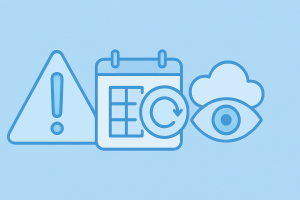
The real challenge with a shutdown like this is the number of people who won’t see it coming.
There are millions of users who don’t follow tech news, who aren’t reading Microsoft’s blog, and who don’t check app updates weekly. They’ll open Skype on May 5 like any other day, and be locked out.
Some will be mid-conversation. Some will be trying to call someone important. Some will assume it’s a bug or outage and waste hours troubleshooting before discovering the truth.
That’s the danger of a quiet shutdown. It doesn’t hit with a bang. It comes as silence.
If you’ve landed on this article ahead of that day, you’re already ahead of the curve. You have time to prepare, time to let others know, and time to make a plan that works for your needs, whether that’s Teams or something else entirely.
What Will Happen After May 5, 2025?
Once Skype goes offline, the app won’t work. Not partially, not with limited features, it simply won’t connect.
That means no calls, no video chats, no messages, and no syncing. The infrastructure Skype depended on — the servers, data access layers, API calls- will be shut down. Even if the app still appears on your phone or laptop, it will become a dead icon. The program might open, but you’ll be met with an error message or redirection prompt. There will be no workaround, no backdoor login, no “light mode” still operating in the background.
Skype’s online portal, used for account settings and Skype Credit management, will also be closed. This affects:
-
Users who manage subscriptions through the Skype site
-
Anyone with a Skype Number (virtual phone number)
-
Those who purchased credits to call landlines or international mobiles
So if you’ve been assuming you can keep calling like usual after the shutdown, even if you don’t use the app much, now’s the time to reset that expectation. There’s no partial access after the shutdown. It’s a full-service sunset.
Will You Still Be Able to Access Your Chat History?
Only if you’ve already exported it before May 5. Once the shutdown is complete, your chat data stored inside Skype will no longer be retrievable through the app or online.
This is important because many users assume their old messages are sitting on a Microsoft server they can revisit later. That’s not the case. Skype’s chat history is linked to your client device and your app login. When those are disconnected, so is your access.
To avoid losing personal or professional conversations, Microsoft recommends downloading a copy of your data using their export tool at https://go.skype.com/export. The process isn’t instant — it can take hours or longer for the download link to be generated, so don’t wait until the last week of April.
Once downloaded, your messages come in an HTML file you can open in any browser. It’s not flashy, but it’s readable. You can scroll through conversations, search text, and archive it however you choose. Think of it as a digital keepsake — or a way to document essential information that would otherwise disappear forever.
What Happens to Skype Credit and Subscriptions?
If you’ve ever added funds to your Skype account, you might still have a balance sitting there. Maybe it’s just a few dollars for calls, or maybe it’s more, especially if you regularly call international numbers.
That credit won’t roll over automatically into Microsoft Teams. The two systems operate separately, and Teams doesn’t use Skype Credit.
Here’s what users need to know:
-
Skype Credit can be refunded in many cases, especially if unused. Microsoft has a refund request system that should remain active up until (and shortly after) the shutdown.
-
Subscriptions, like monthly calling plans or Skype Numbers, will expire when the service ends unless canceled earlier.
-
If you don’t act, Microsoft may auto-cancel your subscriptions without refunding the remaining days. That’s why it’s worth logging in now, checking your account, and deciding how to handle your remaining balance.
Don’t assume these payments will quietly transfer over. Microsoft Teams is built around a different model. If you want to switch to Teams and use calling features, it may require a new setup entirely, with separate billing.
Will Skype for Business Be Affected Too?
It’s easy to confuse “Skype” with “Skype for Business,” especially since both names were used side-by-side for years. But their timelines are different.
Skype for Business was already retired by Microsoft, not in 2025, but earlier. Microsoft began phasing it out in favor of Microsoft Teams as early as 2021, and the corporate version of Skype has already transitioned.
So if you’re using Skype through your workplace (and haven’t been using the consumer app), your organization has likely already moved you to Teams.
The shutdown we’re talking about here is for:
-
Skype for personal use
-
Free Skype accounts created independently
-
Anyone who uses Skype to call friends, family, freelancers, or clients
-
Small businesses are still relying on the consumer version
If you’re unsure which version you’ve been using, here’s a quick way to tell:
If you log in through Skype.com, use your personal Microsoft account, and see contacts like you would on Messenger, you’ve been using the consumer version, and yes, this shutdown affects you.
What About My Microsoft Account — Will I Lose It?

No, you will not lose your Microsoft account. That account is much bigger than Skype, it connects to services like:
-
Outlook email
-
OneDrive cloud storage
-
Xbox
-
Microsoft 365
-
Teams
-
And more
When Skype shuts down, only the Skype-related content will be removed or deactivated. You’ll still be able to use the same login for your email, documents, cloud files, and everything else Microsoft offers.
That said, if your Skype profile includes a unique username (live:username123 or similar), you won’t be able to use that handle to connect with others anymore. It won’t be searchable. It won’t appear in Teams unless you’ve linked accounts.
If you’ve been using your Skype identity as a contact method — for work or family — make sure you update people with your new contact details in advance.
How Much Time Do You Really Have? (A Realistic Breakdown)
Here’s what most users don’t realize: while the official shutdown is May 5, the timeline for cleanly exiting Skype without stress is shorter.
-
Now: Migration prompts are live. Account exports are working. Teams Free is available.
-
Mid-April: Microsoft support is expected to scale down its helpdesk for Skype-related requests. Data export tools may slow as more users flood the system.
-
Final Week of April: Any remaining access issues, payment delays, or migration bugs will be harder to resolve.
-
May 5: Services end entirely. The app becomes non-functional. Data not previously exported is gone for good.
If you wait until the final weekend, you risk long delays or getting locked out entirely.
Think of this like moving out of a house. You don’t wait until the night before the lease ends to start packing, especially if the movers are already loading boxes.
Why Microsoft Made This Decision (And Why It’s Not Personal)
Microsoft didn’t retire Skype out of neglect. The platform was one of their most iconic communication tools — and it shaped an entire era of internet culture. But the way we communicate has evolved. Text isn’t just a message. Video isn’t just a screen. Work and life have blurred, and communication needs to meet both worlds.
Teams was designed to handle this new reality — to merge productivity, collaboration, personal messaging, and file-sharing all into one place.
Skype was great for calls and basic chats, but it never fully evolved into a connected, flexible ecosystem. And once the pandemic hit and remote work surged, Microsoft focused its resources on building out a tool that could do more than video calls. That tool was Teams.
This doesn’t mean Skype failed. It means it served its purpose, and now the world is asking for something different.
Final Words: This Isn’t Just About Tech — It’s About People
It’s easy to treat this like just another app closure. But if Skype has been part of your life, even in small ways, this moment matters. It’s where some of us first heard a grandparent’s voice overseas. Where we closed our first client deal. We stayed in touch during long months apart.
Technology isn’t just code. It’s connection. And when a platform like this disappears, it’s worth pausing, not in fear, but in recognition.
The best way to move forward is to move early. Download what matters. Let people know how to reach you. Choose a new tool that fits your next chapter. Whether that’s Microsoft Teams or something simpler like a direct calling app, you deserve to stay connected without stress.
Skype may be closing its doors, but your conversations don’t have to.

